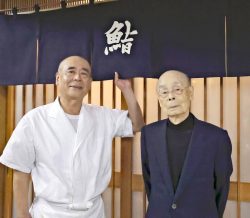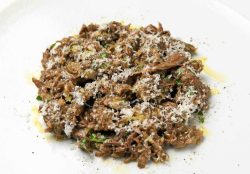
Takumi Takase holds a lunch dish made with Kesennuma salmon shark at his food truck on Feb. 22 in Minato Ward, Tokyo.
12:13 JST, March 7, 2021
It is noon on a weekday in February, and Takumi Takase has a sautee going in the fry pan in his food truck parked in an office district of Tokyo’s Minato Ward. What makes his menu unique is the lone type of meat he uses.
Fancy a shark burger?
Takase, a 33-year-old native of Kawasaki, serves shark meat caught in the Miyagi Prefecture port city of Kesennuma, which was devastated in the Great East Japan Earthquake. He started his business as a means of helping the local fishermen, whom he got to know when volunteering shortly after the disaster.
Takase’s food truck bears the name SAMEYA, meaning “shark shop,” and sports a large, garish flag like those flown on fishing ships. As he settles in for business in downtown Tokyo, he puts out a signboard that spells out his objective: “Sharks shining, and fishermen shining, too; that is the future I am aiming for.”
He has built a good reputation with customers, and just past 1 p.m. on this day, is already sold out.
“I want the food culture of eating shark meat to get started here in Tokyo, while giving a boost to the fishermen of Kesennuma.” Takase said.
When the earthquake struck in March 2011, Takase was a student at Tokyo’s Waseda University, where he was a member of an event planning club that looked at social issues. Seeing the horrifying images of the tsunami, he thought, “I want to look for something I can do for the affected areas.”
One month later, he was off to Ishinomaki, another hard-hit city in Miyagi Prefecture, where he spent three days helping clean mud out of a temple where the remains of victims were kept.
“Even if the debris is cleared away, people won’t be able to come back if no jobs are created,” he thought with a heavy heart.
It was at that time that Takase, through a university friend, became acquainted with a Kesennuma fisherman named Riichi Sasaki.

Takumi Takase, left, poses with fisherman Riichi Sasaki in 2017 in Kesennuma, Miyagi Prefecture.
Work to be proud of
Sasaki, 68, told Takase the experiences he encountered during and after the major earthquake that sent a towering wall of water over the land. His ship survived while others were washed away because he pointed it out to sea, he said. In the aftermath, Sasaki spent about six months helping in the recovery, removing debris and doing other tasks. Even when he was able to resume fishing, he found he could not get enough workers.
Takase took his first ride on a fishing vessel in February 2012. He was overwhelmed by the sight of Sasaki silently reeling in cod, as waves of the wild sea washed over him on the frigid day.
Upon returning to port, he was equally awed when, while eating the cod fresh from the sea, Sasaki commented, “I risk my life to catch fish.”
Takase thought, “Being a fishermen is a job to be highly proud of.”
Even so, Sasaki also told him that he does not want his children to follow him into the profession. “In this day and age, you can’t support a family as a fisherman,” he said.
For Kesennuma, where the fishermen are aging, to make an economic recovery, “It is necessary to make fishing a career people can take 100% pride in,” Takase said. “We need to find ways to increase the value of fish.”
Focus on the positive
Takase chose the salmon shark, a local specialty, for his mission.
Although interest from overseas is high for shark’s fin, it is time-consuming to process shark meat and the market price is only about ¥100 per kilogram. That is only about a tenth of the price fetched for swordfish.
“If demand for high-protein, low-calorie shark meat would increase, it should be able to create a return for the fishermen,” Takase said.
After much trial and error using shark meat from Kesennuma, he came up with recipes for shark pasta, paella, fried rice and other dishes. In 2017, he started his food truck business specializing in the apex predator of the sea.
“[Takase] draws attention to the positive aspects and conveys the appeal of Kesennuma,” said Akihiko Sugawara, president of the Kesennuma Chamber of Commerce and Industry. “We are very grateful.”
Sasaki concurred, adding, “No matter the era, it’s the power of youth that creates new things. We’re happy to have Takumi.”
As he hits the road for another day of business, Takase mulls over new ideas, such as developing processed items to be sold at retail shops or improving port facilities to sustain shark fishing.
His food truck can be found every Monday from 11:30 a.m. to 2 p.m. at the Mita Kokusai Building in the Mita district of Minato Ward. The menu changes daily, and his schedule of appearances at events and other information can be found on SAMEYA’s Instagram account.
"Features" POPULAR ARTICLE
-

Sanrio to Open Museum in Yamanashi Pref. Dedicated to Founder, Exhibits Include Hello Kitty, Other Characters
-

Legendary Sushi Chef Jiro Ono Turns 100: ‘I Have No Regrets’
-

Autumn Foliage Surrounds Visitors to Tokyo’s Showa Kinen Park
-

My Daughter No Longer Speaks to Me, But I Want to See Her and My Grandchild
-

Kumamoto: Public Bath Refurbished as Library Where You Can Chat, Take Photos
JN ACCESS RANKING
-

Keidanren Chairman Yoshinobu Tsutsui Visits Kashiwazaki-Kariwa Nuclear Power Plant; Inspects New Emergency Safety System
-

Imports of Rare Earths from China Facing Delays, May Be Caused by Deterioration of Japan-China Relations
-

University of Tokyo Professor Discusses Japanese Economic Security in Interview Ahead of Forum
-

Japan Pulls out of Vietnam Nuclear Project, Complicating Hanoi’s Power Plans
-

Govt Aims to Expand NISA Program Lineup, Abolish Age Restriction


























